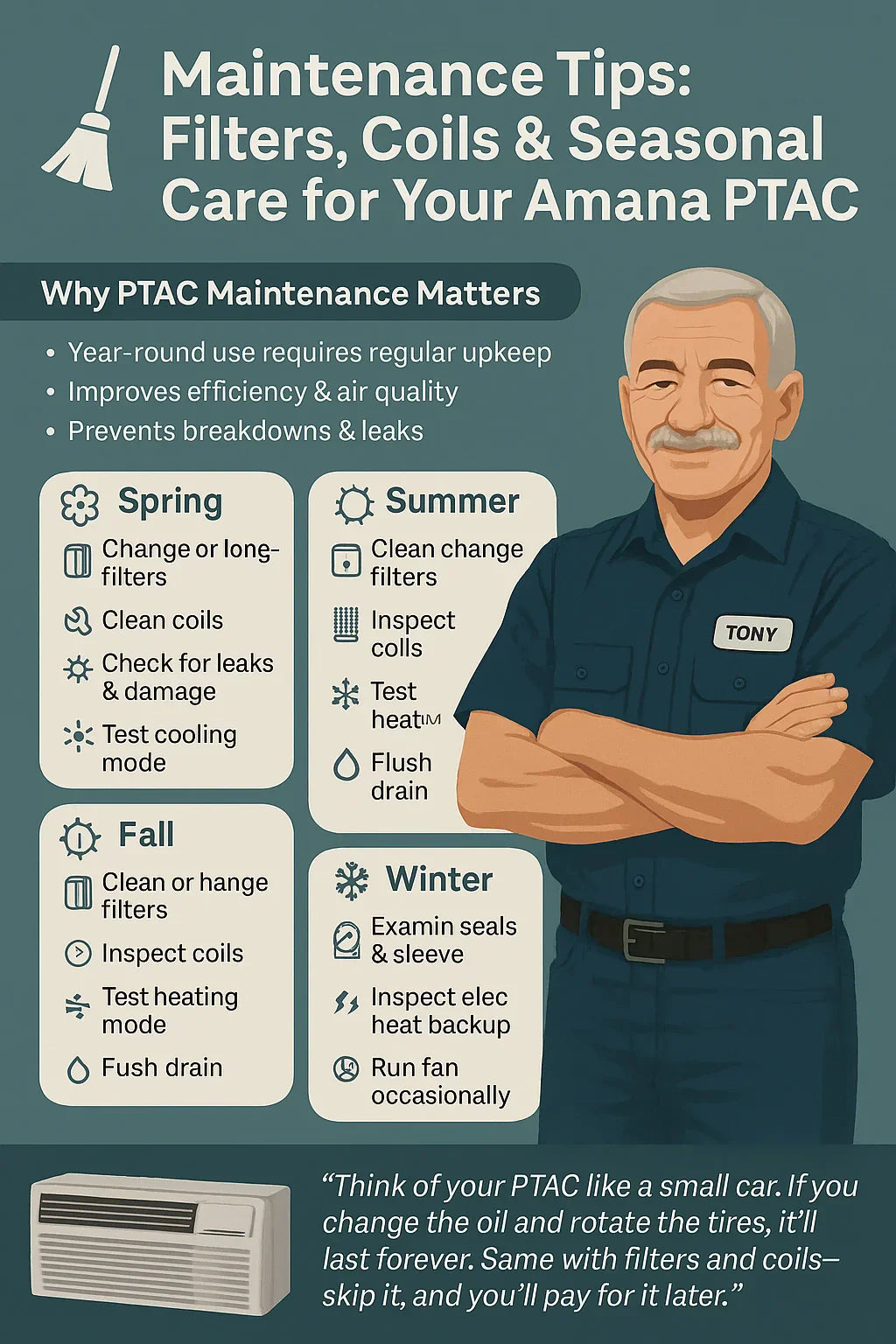When Tony installed his Amana Distinctions 12,000 BTU PTAC Heat Pump with 3.5 kW Electric Backup in his guest apartment, he knew the upfront investment was only part of the story. Like any heating and cooling system, how long it lasts—and how much it costs to run—depends on regular maintenance.
The good news? PTAC units are fairly low-maintenance compared to central HVAC systems. With a little care, Tony keeps his unit running efficiently, his guests comfortable, and his bills under control.
This guide covers everything you need to know about PTAC maintenance, from filter cleaning to coil care and seasonal checklists.
🔍 Why PTAC Maintenance Matters
PTACs are designed for year-round operation—cooling in summer, heating in winter, and even using backup electric heat during freezing nights. That constant use means they need routine attention to stay efficient.
✅ Key Reasons to Maintain Your PTAC:
-
Efficiency: Dirty filters and coils reduce airflow, forcing the unit to work harder (raising energy bills by 10–20%).
-
Air Quality: Dusty or moldy PTACs can circulate allergens.
-
Longevity: Well-maintained PTACs can last 10+ years, while neglected ones may fail in 5–6.
-
Cost Savings: Prevents expensive repairs and water damage from clogged drains.
👉 Reference: Energy.gov – Maintaining Your Air Conditioner.
Tony’s take:
“A PTAC isn’t a set-it-and-forget-it machine. Ten minutes of maintenance a month saves you hundreds in the long run.”
🧼 Filters: Monthly Cleaning
The air filter is your PTAC’s first line of defense. It traps dust, pollen, and debris before they can clog coils or circulate indoors.
How Often?
-
Monthly cleaning is recommended.
-
During pollen season or heavy use, check every 2 weeks.
How to Clean PTAC Filters:
-
Turn off and unplug the PTAC.
-
Slide the filter(s) out from the front grille.
-
Rinse with warm water or wash with mild soap.
-
Let dry completely before reinserting.
-
Replace filters if torn, sagging, or permanently discolored.
👉 Tony’s Tip: “I keep two sets of filters. That way, I can swap them out quickly and clean the dirty set later.”
❄️ Coils: Twice a Year
PTACs have two main coils:
-
Evaporator coil (indoor side): Absorbs heat during cooling.
-
Condenser coil (outdoor side): Releases heat outside.
When dirty, these coils lose efficiency and cause the unit to run longer, raising costs.
When to Clean Coils:
-
Spring: Before cooling season.
-
Fall: Before heating season.
How to Clean Coils:
-
Remove front cover and filter.
-
Use a vacuum with brush attachment to remove dust.
-
Spray coils with a coil cleaner (available at hardware stores).
-
Rinse carefully with low-pressure water.
-
Let dry completely before restarting.
👉 Reference: EPA – Coil Cleaning Best Practices.
Tony’s take:
“Dirty coils are like cholesterol in your PTAC—they clog up the system. Keep ‘em clean, and the air flows like it should.”
💧 Drain & Condensation Management
Every PTAC creates condensation as it cools. If the drain line or pan gets clogged, you risk leaks, mold, or even water damage.
Maintenance Steps:
-
Inspect the drain pan monthly. Empty any standing water.
-
Flush the condensate drain line each season with a mix of water and vinegar.
-
Check the sleeve installation slope—should tilt slightly outward for drainage.
👉 Reference: ASHRAE – Indoor Humidity & Drainage Standards.
🌦️ Seasonal Care Checklist
Tony keeps a seasonal routine to ensure his Amana PTAC is ready year-round.
🌸 Spring (Cooling Prep)
-
Clean/replace filters.
-
Clean evaporator & condenser coils.
-
Test cooling function.
-
Check for air leaks around sleeve.
☀️ Summer (Peak Use)
-
Clean filters monthly (more often in dusty areas).
-
Keep outdoor grille clear of debris (leaves, grass clippings).
-
Monitor for unusual noises or longer run times.
🍂 Fall (Heating Prep)
-
Clean/replace filters.
-
Inspect and vacuum coils.
-
Test heat pump and electric backup.
-
Flush drain line to prevent winter freeze issues.
❄️ Winter (Cold Weather Operation)
-
Ensure backup electric heat is working.
-
Check sleeve insulation to prevent drafts.
-
Inspect condensate drain (avoid freezing).
-
Run unit on fan occasionally to circulate air.
👉 Tony’s Tip: “I treat my PTAC like a car. Each season, it gets a little tune-up—filters, coils, and a quick test run.”
🛠️ Extra Tips for Longevity
Want your Amana PTAC to last beyond a decade? Follow these pro-level tips:
-
Keep Clearance: Maintain 12 inches of open space around the outdoor grille.
-
Control Humidity: Use a dehumidifier in damp climates to reduce workload.
-
Avoid Overuse: Don’t run the unit 24/7—set thermostat to cycle.
-
Inspect Gaskets: Replace cracked or worn rubber gaskets around sleeve.
-
Professional Inspection: Have an HVAC pro check refrigerant levels every 2–3 years.
Reference: Amana PTAC Maintenance Resources.
📊 PTAC Maintenance vs. Other Systems
| System | Maintenance Level | Frequency | Cost |
|---|---|---|---|
| PTAC (Amana) | Filters, coils, drain | Monthly/seasonal | Low |
| Mini Split | Filters, coils, line set check | Monthly/seasonal | Moderate |
| Central HVAC | Filters, ducts, coils, pro tune-ups | Monthly + annual | Higher |
Tony’s observation:
“A PTAC takes less upkeep than central air or mini splits. As long as you clean the filters and coils, it’ll run like a champ.”
🎯 Final Verdict: Keep It Clean, Keep It Running
Regular maintenance isn’t complicated, but it’s the key to maximizing your Amana PTAC’s efficiency and lifespan.
✅ Monthly: Clean filters.
✅ Seasonally: Clean coils, check drains.
✅ Annually: Inspect sleeve, seals, and backup heat.
✅ Every 2–3 years: Professional refrigerant check.
Tony’s advice:
“Think of your PTAC like a small car. If you change the oil and rotate the tires, it’ll last forever. Same with filters and coils—skip it, and you’ll pay for it later.”
In the next topic we will know more about: Troubleshooting Guide: What to Do If Your PTAC Isn’t Heating or Cooling Properly







